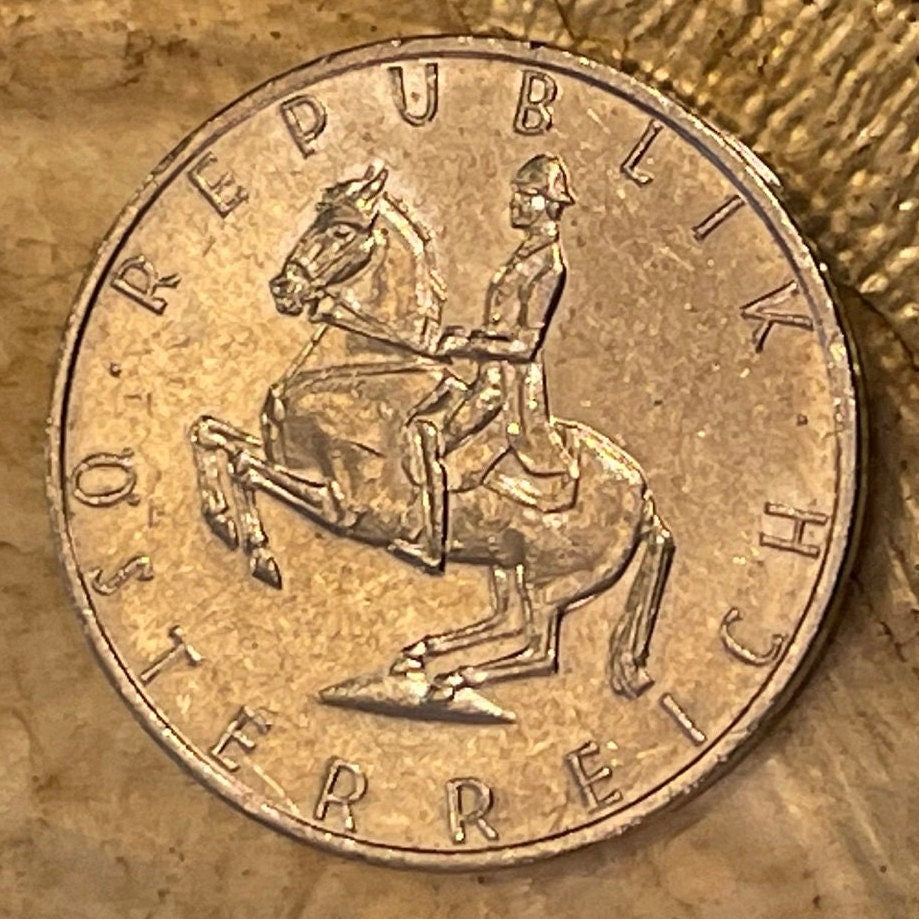elemintalshop
Lipizzaner Stallion 5 Schillings Austria Authentic Coin Money for Jewelry and Craft Making (Horse)
Lipizzaner Stallion 5 Schillings Austria Authentic Coin Money for Jewelry and Craft Making (Horse)
Couldn't load pickup availability
Lipizzaner Stallion 5 Schillings Austria Authentic Coin Money for Jewelry and Craft Making (Horse)
Obverse: Lipizzaner stallion with rider, rearing left.
Lettering: · REPUBLIK · ÖSTERREICH
Reverse: The Austrian escutcheon, the face value and two laurel branches
Binomial Name: Laurus nobilis
Lettering: SCHILLING 5
Features
Issuer Austria
Period Second Republic (1945-date)
Type Standard circulation coin
Years 1968-2001
Value 5 Schilling (5 ATS)
Currency Second Schilling (1945-2001)
Composition Copper-nickel
Weight 4.8 g
Diameter 23.5 mm
Thickness 1.51 mm
Shape Round
Orientation Medal alignment ↑↑
Demonetized 02-28-2002
Number N# 742
References KM# 2889a, Schön# 78a
Wikipedia:
The Lipizzan or Lipizzaner (Croatian: Lipicanac, Czech: Lipicán, Hungarian: Lipicai, Italian: Lipizzano, Slovene: Lipicanec), is a horse breed named for the Lipizza Stud of the Habsburg monarchy. The breed is closely associated with the Spanish Riding School of Vienna, Austria, where the horses demonstrate the haute école or "high school" movements of classical dressage, including the highly controlled, stylized jumps and other movements known as the "airs above the ground." The horses at the Spanish Riding School are trained using traditional methods that date back hundreds of years, based on the principles of classical dressage.
The Lipizzan breed dates back to the 16th century. Its name derives from one of the earliest stud farms established, which was located near Lipica (spelled "Lipizza" in Italian), a village in present-day Slovenia. The breed has been endangered numerous times by warfare sweeping Europe, including during the War of the First Coalition, World War I, and World War II. The rescue of the Lipizzans during World War II by American troops was made famous by the Disney movie Miracle of the White Stallions. The breed has also starred or played supporting roles in many movies, TV shows, books, and other media.
Today, eight stallions are recognized as the classic foundation bloodstock of the breed, all foaled the late 18th and early 19th centuries. All modern Lipizzans trace their bloodlines to these eight stallions, and all breeding stallions have included in their name the name of the foundation sire of their bloodline. Also classic mare lines are known, with up to 35 recognized by various breed registries. The majority of horses are registered through the member organizations of the Lipizzan International Federation, which covers almost 11,000 horses in 19 countries and at 9 state studs in Europe. Most Lipizzans reside in Europe, with smaller numbers in the Americas, South Africa, and Australia. Generally gray in color, the Lipizzan is a breed of Baroque type that is powerful, matures slowly, and noted for longevity.
"Airs above the ground"
The "airs above the ground" are the difficult "high school" dressage movements made famous by the Lipizzans. The finished movements include:
The levade is a position wherein the horse raises up both front legs, standing at a 30° angle entirely on its hind legs in a controlled form that requires a great deal of hindquarter strength. A less difficult but related movement is the pesade, where the horse rises up to a 45° angle.
The courbette is a movement where the horse balances on its hind legs and then essentially "hops", jumping with the front legs off the ground and hind legs together.
The capriole is a jump in place where the stallion leaps into the air, tucking his forelegs under himself, and kicks out with his hind legs at the top of the jump.
Other movements include:
The croupade and ballotade are predecessors to the capriole. In the croupade, the horse jumps with both front and hind legs remaining tucked under the body and he does not kick out. In the ballotade, the horse jumps and untucks his hind legs slightly, he does not kick out, but the soles of the hind feet are visible if viewed from the rear.
The mezair is a series of successive levades in which the horse lowers its forefeet to the ground before rising again on hindquarters, achieving forward motion. This movement is no longer used at the Spanish Riding School.
Share










The coin is beautiful! I had ordered 6 coins in total and all of them are great. The packaging was top notch. They arrived quickly and in perfect shape. Thank you!
Excellent quality. Thanks very much!
5 stars review from Dawn
Wonderful!! I have always Love the Lipizzaner Horses and their story of survival during the WWII!! Thank You!!
5 stars review from Catherine









